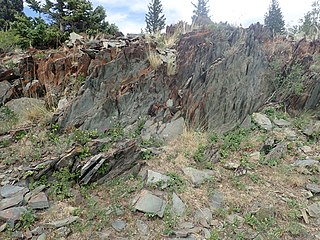
The Vishnu Basement Rocks is the name recommended for all Early Proterozoic crystalline rocks exposed in the Grand Canyon region. They form the crystalline basement rocks that underlie the Bass Limestone of the Unkar Group of the Grand Canyon Supergroup and the Tapeats Sandstone of the Tonto Group. These basement rocks have also been called either the Vishnu Complex or Vishnu Metamorphic Complex. These Early Proterozoic crystalline rocks consist of metamorphic rocks that are collectively known as the Granite Gorge Metamorphic Suite; sections of the Vishnu Basement Rocks contain Early Paleoproterozoic granite, granitic pegmatite, aplite, and granodiorite that have intruded these metamorphic rocks, and also, intrusive Early Paleoproterozoic ultramafic rocks.

The Manzano Group is a group of geologic formations in central New Mexico. These have radiometric ages of 1601 to 1662 million years (Ma), corresponding to the late Statherian period of the Paleoproterozoic.

The Moppin Complex is a Precambrian geologic complex found in the Tusas Mountains of northern New Mexico. It has not been directly dated, but is thought to be Statherian based on a minimum age of 1.755 Gya from radiometric dating of magmatic intrusions.

The Maquinita Granodiorite is a Precambrian pluton that crops out in the northern Tusas Mountains of New Mexico. It has a radiometric age of 1.755 billion years, corresponding to the Statherian period.

The Vadito Group is a group of geologic formations that crops out in most of the Precambrian-cored uplifts of northern New Mexico. Detrital zircon geochronology and radiometric dating give a consistent age of 1700 Mya for the group, corresponding to the Statherian period.

The Big Rock Formation is a formation that crops out in the Tusas Mountains of northern New Mexico. Detrital zircon geochronology gives a maximum age for the formation of 1665 Mya, corresponding to the Statherian period.

The Harding Pegmatite Mine is a former adit mine that extracted lithium, tantalum, and beryllium from a Precambrian pegmatite sill. It ceased operations in 1958 and its owner, Arthur Montgomery, donated it to the University of New Mexico, which runs the site as an outdoor geology laboratory with mineral collecting permitted on a small scale.

The Glenwoody Formation is a geological formation that is exposed in the cliffs southeast of the Rio Grande Gorge near the town of Pilar and in a few other locations in the Picuris Mountains. Its minimum age from detrital zircon geochronology is 1.693 Mya, corresponding to the Statherian period.

The Hondo Group is a group of geologic formations that crops out in most of the Precambrian-cored uplifts of northern New Mexico. Detrital zircon geochronology gives a maximum age for the lower Hondo Group of 1765 to 1704 million years (Mya), corresponding to the Statherian period.

The Ortega Formation is a geologic formation that crops out in most of the mountain ranges of northern New Mexico. Detrital zircon geochronology establishes a maximum age for the formation of 1690-1670 million years (Mya), in the Statherian period of the Precambrian.

The Rinconada Formation is a geologic formation that crops out in the Picuris Mountains of northern New Mexico. Detrital zircon geochronology establishes a maximum age for the Rinconada Formation of about 1723 Mya, placing it in the Statherian period of the Precambrian.

The Pilar Formation is a geologic formation that crops out in the Picuris Mountains of northern New Mexico. It has a radiometric age of 1488 ± 6 million years, corresponding to the Calymmian period.

The Marquenas Formation is a geological formation that crops out in the Picuris Mountains of northern New Mexico. Detrital zircon geochronology gives it a maximum age of 1435 million years, corresponding to the Calymmian period.

The Tres Piedras Orthogneiss is a pluton in northern New Mexico. It has a U-Pb radiometric age of 1693 Mya, placing it in the Statherian period.

The San Pedro quartz monzonite is a Paleoproterozoic pluton in New Mexico. It has a radiometric age of 1730 Mya, corresponding to the Statherian period.

The Joaquin quartz monzonite is a Mesoproterozoic pluton in northern New Mexico. Radiometric dating gives it an age of 1460 million years, corresponding to the Calymmian period.

The Sevilleta Metarhyolite is a geologic formation in central New Mexico. It has a radiometric age of 1665 ± 16 Ma, corresponding to the Statherian period.

The Tin Mountain pegmatite is an igneous intrusion located in the southern Black Hills, South Dakota. It is a part of the Harney Peak Granite dome that formed in the Late Paleoproterozoic around 1.7 billion years ago. The Harney Peak Granite system includes thousands of pegmatites, one of which is the Tin Mountain. The Tin Mountain pegmatite is rich in lithium, but was first mined in search of tin, which gave the mountain its name.
The Blue Springs Formation is a geologic formation exposed in the Los Pinos Mountains of central New Mexico.

The Abajo Formation is a geologic formation in the Los Pinos Mountains of central New Mexico. It was deposited about 1660 million years (Ma) ago, corresponding to the Statherian period.





















